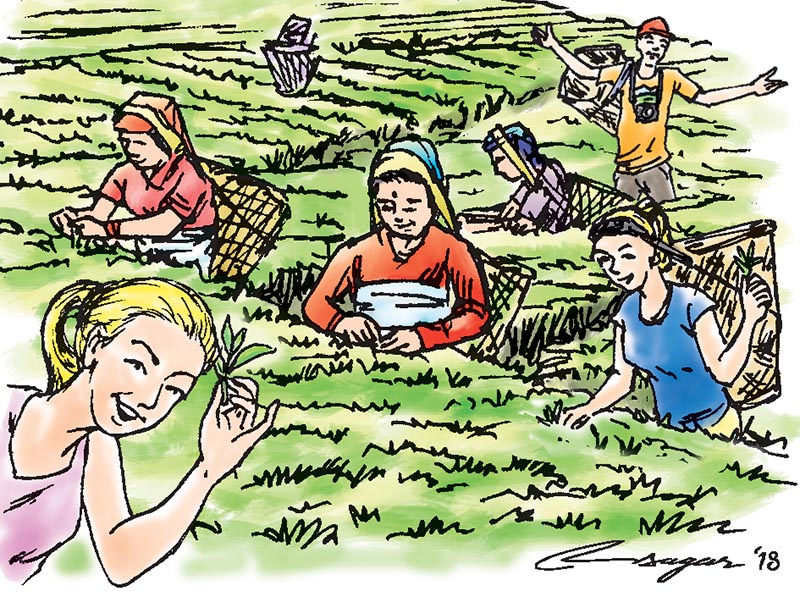Tea tourism: Promoting Nepali product
Some of the features that can be introduced to attract tourists can be visits to the homes of workers to learn about their lives; treks through tea estates; tours to tea processing factories and first-hand experience of how tea leaves are plucked
When it comes to tea, or tea gardens for that matter, the place that comes to our mind is Ilam, a far-eastern district in Nepal. Ilam is a tea heaven, as it has the right combination of soil and climate conditions for growing tea leaves.
Tea is grown in around a three dozen districts of Nepal these days but Ilam appears on the top for producing tea leaves with distinctive aroma and taste. Ilam has a rich history and tradition of tea plantation. It is now the right to time to promote Nepali tea and tea growing areas in the global market. While tea can help growers earn money, systematic development of tea gardens can also turn the regions where it is grown into tourist destinations. Thus, the country as a whole can earn from what we can say tea tourism.
According to data of Nepal Tea and Coffee Development Board, Nepal produces altogether 24,200 tonnes of tea on an average every year, of which 5,800 tonnes is orthodox tea. Similarly, Nepal is exporting tea (basically orthodox) worth almost Rs 2.4 billion every year.
Thousands of people are employed in more than 50 tea refinement factories across the country. This way, there are dual benefits from tea industries—on the one hand they support the national economy by producing exportable tea and increase job opportunities and on the other, they tourists.
China, where tea is believed to have originated, has a museum dedicated for tea conservation. This also functions as an institute for people who want to know everything about tea—its history, plantation, culture associated with tea farming and tea drinking and refinement. The jungle from where tea was introduced for the first time 3,000 years ago is a declared a conservation area. Thousands of tea experts from around the world visit the place to learn and share knowledge about tea. Tourists in huge numbers visit the area to enjoy the tea gardens. Similarly, Sri Lanka and Kenya are also famous for their tea gardens in the world. Japan’s initiative to change tea production sites into lucrative tourist businesses is also notable. Chinese and Japanese people take tea not only as a drinking substance but as an epitome of their civilisation. These countries also organise “tea testing ceremonies” annually where tea enthusiasts form around the world gather to take a sip of the unique flavour of tea.
Tea has become a part of livelihood in these countries and it is served as one of the basic components to express their respect and hospitality to the guests. Hilly regions of India like Darjeeling and Assam are famous for tea plantations, which attract tourists in droves. In Uttarakhand of India, the state government is taking initiatives to promote tea tourism. The concept of tea and tourism is not only linked with natural beauty of its gardens. Tea enthusiasts around the world encourage people to understand the health benefits of tea. Especially westerners are more aware about the benefits tea.
Tea tourism means visitors can stroll around the serene tea gardens or learn about the entire production process. People can also visit the factories to know about the tea refinement process, which could be a fascinating experience altogether.
Tea gardens enhance the natural beauty of hills. Tea production which was started in Nepal 150 years ago has finally started becoming a source of earning for many. Even local people are earning a living from tea farming at a small level, which has supported livelihood of many households. This has also uplifted the economic status of locals.
Nepal basically produces CTC and orthodox tea. Since the latter has higher demand in the foreign market, it has high export potential. Promoting tea tourism will mean introduction of more hospitality businesses in the area where tea is planted. This will ultimately result in more employment opportunities. Hence tea tourism has multiple benefits.
Learning from India, China, Sri Lanka and Kenya among others, where thousands of tourists come to know about tea and gain wonderful experience of tea farming zones, Nepal also now needs to focus on promoting tea tourism.
With new federal set-up already in place, governments at local and provincial levels should work to bring appropriate policies for tea growers. The most effective way can be providing tea farmers with necessary hospitality management skills and teach them how their tea gardens can attract tourists.
The private sector should be encouraged to invest in this sector. Similarly, new and short trekking routes should be identified for tourists to stroll around the tea gardens.
Developing the traditional and historical tea gardens of Ilam can be developed as “open tea museum”. Tea festivals on annual basis in tea plantation districts can also be helpful in attracting tourists. Such festivals can be a good platform for orienting tourists about the tea culture in the country. Some of the features that can be introduced to attract tourists can be visits to the homes of tea workers to learn about their lives; treks through tea estates, tours to tea processing factories and first-hand experience of how tea leaves are plucked. Though a simple procedure, for tourists seeing how tea leaves are plucked off by people with a deft motion of their nimble fingers can be a sheer joy. It is high time Nepal started promoting Nepali tea and tea tourism.
Gautam is a tea entrepreneur






